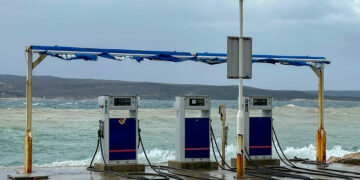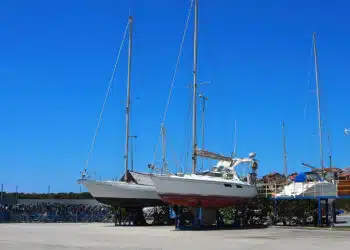They have to fit on command, long pondering about the right line guidance or even trial and error not only enrages the skipper on board, but also threatens to mess up maneuvers and put ship and crew in unnecessary danger: Knots. They are only properly tied when they do not give way under load, but can easily be “untied” without load. Essential for everyone on board, whether on a sailing yacht, a leisurely motorboat or a speedy tender.
The catch when learning the most important knots: Water sports enthusiasts, especially sailors, sometimes have a very own language. And knots, with their sometimes odd names, are peppered with expressions you’d never use otherwise.
Knot with weird names
A stek is not a steak and therefore not edible. By a stek, water sports enthusiasts refer to a knot that is stable and holds only when used together with two lines or an object. The elementary knots sheet and stopper stek only work with two lines. A knot, such as figure-eight or square knot, on the other hand, is stable in itself. Unfortunately, the sailors who gave the knot its name have not been consistent with this definition. The famous bowline knot does not need any other object or second line. In fact, it could have been called a pile knot.
Knot with bays and eyes
A bay is not only a worthwhile destination for the trip, but also a U-shaped loop of a line. When the two ends of a line cross, the bay becomes an eye. And when you ask someone on board to take one more swing, it’s not about letting your fists fly. A stroke on board is a full wrap around a round object like the railing wire or even a line.
What remains to be clarified is what is meant by someone expecting you to occupy something. Anyone who now jumps into the galley and arranges appetizing little sandwiches is sadly mistaken. To occupy something means to tie the knot to something, for example, a cleat on board or a bollard in the harbor.
And when the skipper thinks you should put something on slip, he’s not thinking about underwear. He wants the knot to be covered with a bight that can be pulled open with one hand so that the knot comes undone quickly. The simplest slip knot is the slipstek, where the line is just pulled through a ring and secured with a bight – the right knot for quickly tying the dinghy to the pier when you just want to make a quick trip to the bakery.
The bowline, the classic knot
The bowline is the knot that every water sports enthusiast should know – regardless of whether the helm or the sun deck is his favorite place. Indispensable when it comes to laying a line with a fixed eye over a pole or deploying a lifeline.
The mnemonic that has been used to explain to generations of water sports enthusiasts how to make a bowline and when to put which part of the line through where seems almost like a little story. “The snake comes out of the lake, crawls around the tree and goes back into the water.” Others have a frog jump out of the pond instead of a snake and then jump back in later. Whether snake or frog, the most important detail of the bowline is that the loose part is next to the knot. Only then the bowline cannot be tightened or widened, the eye remains stable in its size.

Mit dem Laden des Videos akzeptieren Sie die Datenschutzerklärung von YouTube.
Mehr erfahren
The knot for the fenders
Who has not already changed from pure knot phobia to snap hooks for the fenders, should know this simple fender knot, which is professionally also called Webleinenstek or Webeleinstek, off the cuff.
The job of fastening the fenders to the railing with a fender knot when entering the marina can already be done by very young sailors and sailing novices on board.

Mit dem Laden des Videos akzeptieren Sie die Datenschutzerklärung von YouTube.
Mehr erfahren
In order for the fender knot to hold securely, it is often secured with a half hitch.

Mit dem Laden des Videos akzeptieren Sie die Datenschutzerklärung von YouTube.
Mehr erfahren
For those who want to untie the fender knot quickly, occupy the end on slip so that the fender knot can be untied quickly with a simple pull.

Mit dem Laden des Videos akzeptieren Sie die Datenschutzerklärung von YouTube.
Mehr erfahren
Sheet knot, the knot for two lines
How do you knot two lines of different thicknesses safely and quickly? With a connecting knot. The best-known of them is the Schotstek. This requires a bit of practice and must be carefully tightened so that it does not slip. There is also a catchy phrase for the simple sheet knot: “The snake comes out of the pond from below, wraps around the tree past it on the left, and then snakes its way out from above under the snake, which is just coming out of the pond.

Mit dem Laden des Videos akzeptieren Sie die Datenschutzerklärung von YouTube.
Mehr erfahren
With this knot, double is better – often a double sheet hitch is better than a single sheet hitch. In a double sheet knot, a single sheet knot is supplemented by another twist at the end. This knot is especially suitable for lines that are noticeably different in thickness and strength.

Mit dem Laden des Videos akzeptieren Sie die Datenschutzerklärung von YouTube.
Mehr erfahren
The knot for tying: Round turn with two half strokes
Quickly pull the line through the metal ring on the pier and moor it – it’s easy with a simple round turn, secured with two half strokes. And if you’ve been paying close attention, you’ll notice that the half strokes after the round turn are nothing more than the webleinenstek or fender knot just explained.

Mit dem Laden des Videos akzeptieren Sie die Datenschutzerklärung von YouTube.
Mehr erfahren
The figure-eight knot for belaying
Sailors in particular need to know how to quickly make a “figure eight” on the end of halyards and sheets. The simple figure-eight knot, also known as the end eight, prevents lines and sheets from involuntarily “rushing out” through blocks and grommets and then having to be laboriously pulled back in. Motorboat skippers tend to have less need for the practical figure-of-eight knot, which is wound like a pretzel.

Mit dem Laden des Videos akzeptieren Sie die Datenschutzerklärung von YouTube.
Mehr erfahren
The figure-eight knot is not limited to its maritime uses: Mountaineers and climbers use a double figure-eight knot for roping. And what protects on the mountain also helps when you need to get into the mast on board!
In addition, there are three other variations of the figure-eight knot: Very practical and sometimes an alternative to the bowline is the figure-eight knot with a laid loop, which you can comfortably put over an object. If, for example, it is a question of firmly connecting a carabiner to the rope, a figure-eight knot with a tucked loop is used. Another variant is the figure-eight knot with a large loop laid in a teardrop shape. This is mainly used by climbers when they have to abseil. In this function, it can also be used on board, when it is necessary to rescue an injured person from the water.

Mit dem Laden des Videos akzeptieren Sie die Datenschutzerklärung von YouTube.
Mehr erfahren

Mit dem Laden des Videos akzeptieren Sie die Datenschutzerklärung von YouTube.
Mehr erfahren

Mit dem Laden des Videos akzeptieren Sie die Datenschutzerklärung von YouTube.
Mehr erfahren

Mit dem Laden des Videos akzeptieren Sie die Datenschutzerklärung von YouTube.
Mehr erfahren
The knot that won’t slip
The stopper knot keeps what its name promises. Namely, its position on the other line. Means: The knot pinches in one direction, so it is firm and can not slip. It stops. The second advantage of the stopper hitch is that it can still be used when the other line is under extreme tension.
Sailors like to use the stopper bar to relieve the sheet in case of an overrun on the winch, for all skippers the stopper bar is indispensable when it comes to pulling a dislocated anchor chain back in piece by piece.

Mit dem Laden des Videos akzeptieren Sie die Datenschutzerklärung von YouTube.
Mehr erfahren
Cross knot: Chic and practical
For those who have learned the sheet knot, the attractive square knot used to join two lines of equal thickness is a laugh. The square knot looks especially good when using two lines of different colors, but of the same material. Important detail: the two parts, which are the ends of the lines, must be on the same side of the square knot outside. Then the square knot, properly tightened, will be difficult to untie.

Mit dem Laden des Videos akzeptieren Sie die Datenschutzerklärung von YouTube.
Mehr erfahren
Tightening a cleat
Also integral part of the knots that every water sportsman should know: Mooring on a cleat. Looks easy as pie, and in fact it is. To tie on a cleat, the line is simply placed around the base of the cleat with a round turn and then passed over the cleat in a crisscross pattern several times. If you want, you can then top the end with a headstroke, where the end of the line is placed under the last eye.

Mit dem Laden des Videos akzeptieren Sie die Datenschutzerklärung von YouTube.
Mehr erfahren
Webleinenstek thrown
Around a thick bollard in the harbor, when you are on the way to the restaurant with the dinghy, you can also moor with a thrown webleinenstek. For the thrown weaving line hitch, the two loops are preformed with the hands and then thrown over the bollard, the knot then tightens under tension. The main advantage of the thrown weaving line hitch over a bollard compared to the bowline hitch is that passing pranksters or children cannot simply unhook the line, thus protecting the dinghy from an involuntary unmanned solo trip.

Mit dem Laden des Videos akzeptieren Sie die Datenschutzerklärung von YouTube.
Mehr erfahren
And what other knots?
The list of (necessary) knots for water sportsmen:inside is almost inexhaustible. And if you have become a real knot expert, you can continue your education with Fancy Artwork on ropes, splice them yourself and make small works of art and practical everyday helpers for use on board. But the necessity of diamond knots, boatswain’s mate knots or even Turk’s waistbands in practical everyday life on board is very limited.
First of all, it is important to have the right knot ready and to be able to execute it safely, almost in one’s sleep. Even in beginner groups, young sailors learn to tie the bowline behind their backs, which is feared by many. And the strange technical terms used on board. Clearly, all those who bear responsibility on board, skippers, helmsmen and “old hands”, must master and apply the most important knots all safely. And then on longer trips, in the doldrums or lying comfortably in the anchorage, patiently teach all the other crew members knot by knot. If the knots sit perfectly, towing and mooring maneuvers can be executed with impressive aplomb.













